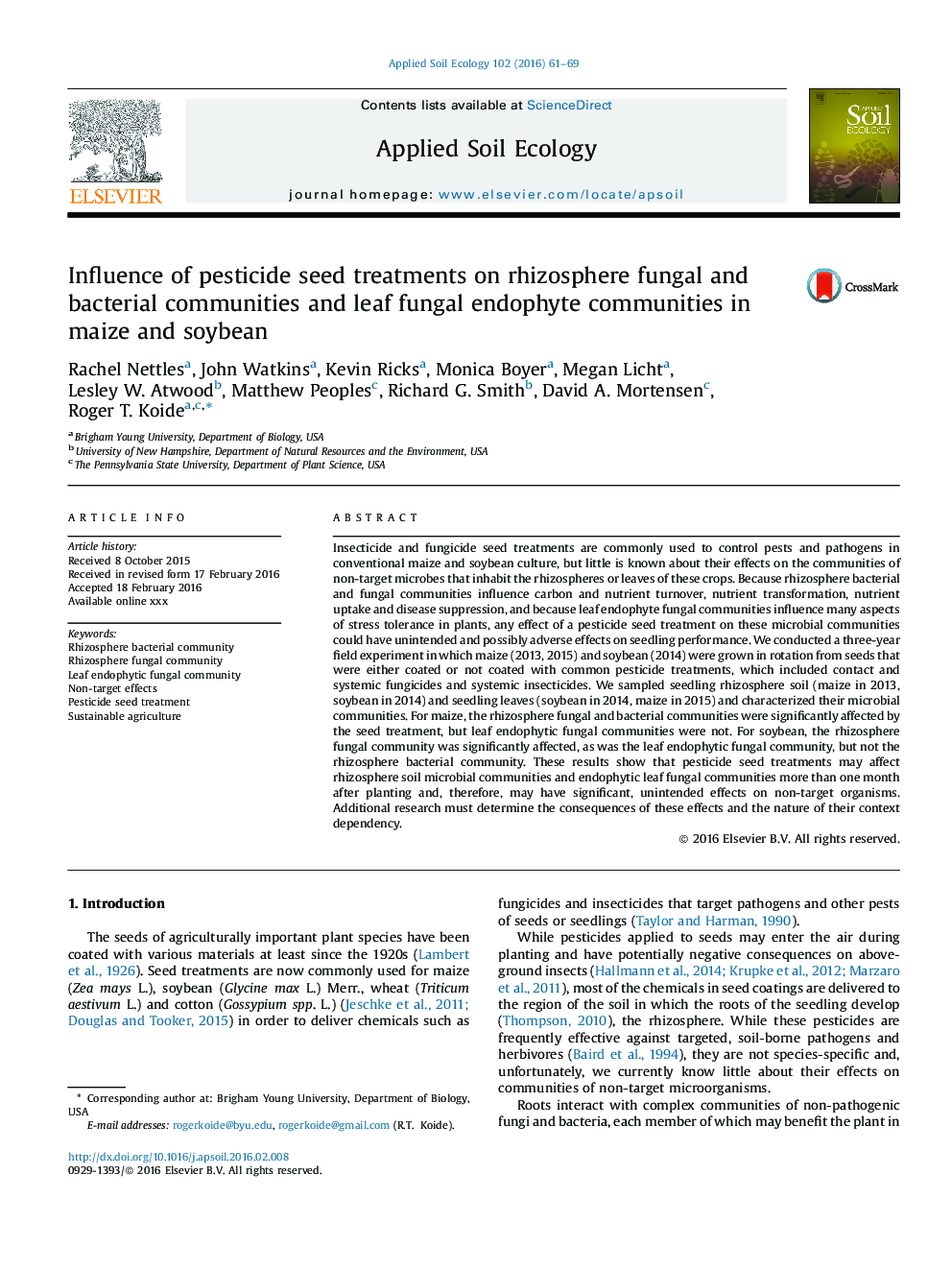| کد مقاله | کد نشریه | سال انتشار | مقاله انگلیسی | نسخه تمام متن |
|---|---|---|---|---|
| 6297577 | 1617781 | 2016 | 9 صفحه PDF | دانلود رایگان |
عنوان انگلیسی مقاله ISI
Influence of pesticide seed treatments on rhizosphere fungal and bacterial communities and leaf fungal endophyte communities in maize and soybean
ترجمه فارسی عنوان
تأثیر تیمارهای تیمار آفت کش ها بر جوامع قارچ و باکتری ریزوسفر و جوندگان برگ اندوفیتی برگ در ذرت و سویا
دانلود مقاله + سفارش ترجمه
دانلود مقاله ISI انگلیسی
رایگان برای ایرانیان
کلمات کلیدی
جامعه باکتریایی ریزوسفر، جامعه قارچ ریشسفر، جامعه قارچ اندوفیت برگ، اثرات غیر هدف، درمان بذر آفت کش ها، کشاورزی پایدار،
ترجمه چکیده
گیاهان حشره کش و قارچ کش معمولا برای کنترل آفات و پاتوژن ها در محصوالت ذرت و سویا استفاده می شود، اما در مورد اثرات آنها در جوامع غیرمستقیم که در ریزوسفر یا برگ این محصولات قرار دارند، کم است. از آنجایی که جوامع باکتری و قارچی ریزوسفر بر محتویات کربن و مواد مغذی، تغییرات مواد مغذی، جذب مواد مغذی و سرکوب بیماری ها تاثیر می گذارند و چون جوامع قارچی اندوفیت برگ بسیاری از جنبه های تحمل استرس در گیاهان را تحت تاثیر قرار می دهند، هر اثر درمان بذر سموم در این جوامع میکروبی می تواند ناخواسته و احتمالا اثرات نامطلوب بر عملکرد نهال. ما یک آزمایش سه ساله انجام دادیم که در آن ذرت (2013، 2015) و سویا (2014) در دانه های روغنی رشد کرد که همگی پوشش داده شده بودند و یا با درمان های معمول سموم دفع نشده شامل قارچ کش و سیستمیک و حشره کش ها نبودند. ما از خاک گیاهخوار ریزوسفر (ذرت در سال 2013، سویا در سال 2014) و برگ گیاهچه (سویا در سال 2014، ذرت در سال 2015) و جوامع میکروبی آنها را مشخص می کنیم. برای ذرت، جوامع قارچی و باکتری ریزوسفر به طور معنی داری تحت تاثیر درمان بذر قرار گرفتند، اما جوامع قارچی اندوفیتی برگ نداشتند. برای سویا، جامعه قارچی ریزوسفر به طور قابل توجهی تحت تاثیر قرار گرفت، همانطور که قارچ برگ اندوفیتیک بود، اما نه جامعه باکتریایی ریزوسفر. این نتایج نشان می دهد که درمان های دانه آفتابگردان ممکن است بیش از یک ماه پس از کاشت بر روی جوامع میکربی خاک و گیاهان اندوفیفتی قارچ برگ تاثیر بگذارد و بنابراین ممکن است اثرات ناخواسته بر موجودات غیر هدف داشته باشد. تحقیقات اضافی باید عواقب این اثرات و ماهیت وابستگی به مواد را تعیین کند.
موضوعات مرتبط
علوم زیستی و بیوفناوری
علوم کشاورزی و بیولوژیک
بوم شناسی، تکامل، رفتار و سامانه شناسی
چکیده انگلیسی
Insecticide and fungicide seed treatments are commonly used to control pests and pathogens in conventional maize and soybean culture, but little is known about their effects on the communities of non-target microbes that inhabit the rhizospheres or leaves of these crops. Because rhizosphere bacterial and fungal communities influence carbon and nutrient turnover, nutrient transformation, nutrient uptake and disease suppression, and because leaf endophyte fungal communities influence many aspects of stress tolerance in plants, any effect of a pesticide seed treatment on these microbial communities could have unintended and possibly adverse effects on seedling performance. We conducted a three-year field experiment in which maize (2013, 2015) and soybean (2014) were grown in rotation from seeds that were either coated or not coated with common pesticide treatments, which included contact and systemic fungicides and systemic insecticides. We sampled seedling rhizosphere soil (maize in 2013, soybean in 2014) and seedling leaves (soybean in 2014, maize in 2015) and characterized their microbial communities. For maize, the rhizosphere fungal and bacterial communities were significantly affected by the seed treatment, but leaf endophytic fungal communities were not. For soybean, the rhizosphere fungal community was significantly affected, as was the leaf endophytic fungal community, but not the rhizosphere bacterial community. These results show that pesticide seed treatments may affect rhizosphere soil microbial communities and endophytic leaf fungal communities more than one month after planting and, therefore, may have significant, unintended effects on non-target organisms. Additional research must determine the consequences of these effects and the nature of their context dependency.
ناشر
Database: Elsevier - ScienceDirect (ساینس دایرکت)
Journal: Applied Soil Ecology - Volume 102, June 2016, Pages 61-69
Journal: Applied Soil Ecology - Volume 102, June 2016, Pages 61-69
نویسندگان
Rachel Nettles, John Watkins, Kevin Ricks, Monica Boyer, Megan Licht, Lesley W. Atwood, Matthew Peoples, Richard G. Smith, David A. Mortensen, Roger T. Koide,
